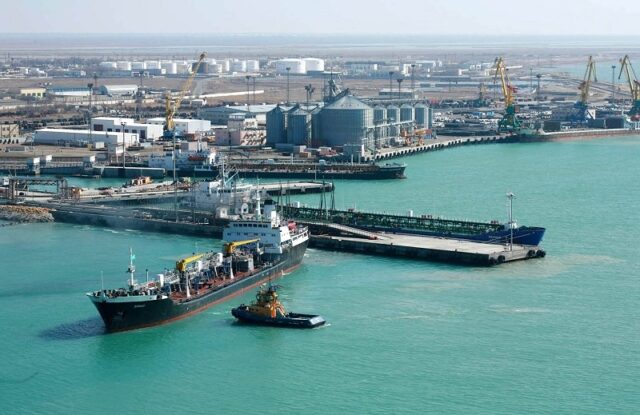
Moscow Shifting Focus to Sea Lanes Rather Than Railways for North-South Corridor
Publication: Eurasia Daily Monitor Volume: 20 Issue: 127
By:

When Moscow announced plans in 2000 for the creation of a north-south trade corridor, its initial goal was to bypass the Suez Canal; however, recently, this passage has been used primarily to evade Western sanctions (Realtribune.ru, November 30, 2022). The Russian authorities have focused on the development of a railway network as the basis of the corridor, but problems with the land routes both east and west of the Caspian have significantly delayed the completion of these lines. The long-discussed Resht link, for example, was recently delayed for the third time and will not open until 2028 at the earliest (see EDM, May 16, 2022; January 4; Rzd-partner.ru, July 26).
Other problems regarding rail links between Iran and its neighbors do not have any immediately obvious solutions (Ritmeurasia.org, January 28; Company.rzd.ru, accessed August 8). This is forcing Moscow to shift its attention first to the use of sea lanes in the Caspian Sea and then to corridors running from Iranian railways to Iranian ports from which cargo can be shipped to India and other destinations further afield (Ritmeurasia.org, July 8). But given Russia’s problems with shipping and intermodal trade, as well as the lack of rail infrastructure connecting Iranian ports to routes to the north, this shift may not give Moscow either the economic or political gains it clearly seeks.
Instead, this adjustment seems set to trigger new geo-economic and geopolitical competition both in the Caspian and the Indian Ocean. The former is already taking shape, but the latter almost certainly could prove more significant. On the Caspian, Kazakhstan and the other littoral states are already becoming competitors for Russian shipping to Iran (see EDM, April 25, August 1; Eldala.kz, August 2; Gov.kz, August 7; Iran.ru, August 8). As a result, these countries have been developing naval capacities that will allow them to project power more effectively should Moscow try to limit access to those ports (see EDM, June 24, 2021, April 25). This is not to say that there are likely to be any military clashes in the near term, but rather it is to point out that, as siltation in the Caspian reduces the size of the routes larger ships can use, tensions among the littoral states are almost certain to increase regarding access to the remaining transit lanes (Window on Eurasia, July 19). Consequently, while Russia’s shift from land to sea as its priority route in this corridor may have allowed it to avoid some problems, it has created new ones that may prove even more difficult.
The situation in the Indian Ocean south of Iran, however, is likely to prove more immediately explosive as Tehran is willing to deploy its navy to protect not only its ports but ships carrying cargo from Russia as well. Western powers are interested in maintaining sanctions on both Iran and Russia and are prepared to use various means to restrict such shipping, including stripping ships of insurance protection. However, regional powers opposed to any expansion of Iranian influence are almost certain to react if Russia is able to overcome the problems in the links of Iranian ports to Iranian railways and in intermodal transit (see China Brief, January 17, 2020, November 3, 2022; Interaffairs.ru, July 26, 2022; Fondsk.ru, December 15, 2022).
Despite all these potential risks—and perhaps given Russian President Vladimir Putin’s approach to international affairs—Moscow now feels compelled to focus on the use of intermodal trade via ports on the Caspian and Indian Ocean as the preferred method for developing the north-south corridor rather than waiting for rail lines to be completed. This was signaled last month by Russian Deputy Prime Minister Marat Khusnullin during a Russian Federation Council hearing (TASS, July 18). In his remarks, Khusnullin made clear that Moscow will continue to press forward with rail development but will increasingly use the Caspian Sea in the northern section of the north-south trade corridor and Iranian ports in the southern section. The Russian deputy premier’s remarks are the clearest indication yet that the Russian government has not seen sufficient immediate returns from rail developments and thus feels compelled to shift gears, despite Moscow’s shortage of ships for such trade, its shortcomings in handling intermodal trade and even its lack of a sufficient number of merchant marine sailors. This is all compounded with problems at the primary Iranian ports on the Indian Ocean regarding connections to rail lines leading northward. (On these problems, see the extremely critical comments of Russian experts at Window on Eurasia, August 22, 2022)
This development carries an important message for Western analysts and policymakers. Just as in the case of Ukraine, where actions on the sea may prove almost as consequential as those on land (see EDM, July 25), so, too, does Moscow’s decision to shift its priorities away from rail lines to sea lanes in the south. Naval issues will become more important in the Caspian and the Indian Ocean, not only for the littoral states but also for their supporters and competitors further afield (see EDM, June 7). And as with Ukraine and the Black Sea, Moscow must not steal a march on the West because of what some have called the West’s “sea blindness.” Instead, Western powers must recognize that Moscow, as has so often been the case, is trying to gain an advantage where few are looking and then take steps to ensure that this combined Russian-Iranian effort fails rather than succeeds.



